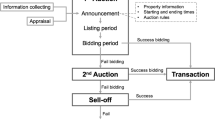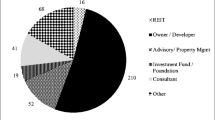Abstract
This paper examines valuation and its relation to information production by licensed appraisers across real estate markets. The testable implications are discussed for either a peer monitoring or a crowding out effect in the data. The empirical model is estimated with data for all 50 US states and DC covering the sample period from 1999 to 2008. While analysis is primarily cross-sectional and not causal, the evidence is consistent with theory stating that the minimum quality associated with residential licensure standards may be too low. In contrast, the evidence suggests certified residential standards afford information producers the opportunity to signal or information consumers the ability to screen based on quality.
Similar content being viewed by others
Notes
This work benefited from a number of excellent points raised by anonymous referees. We are particularly grateful to an anonymous referee’s suggestion that we augment our initial analysis of price-to-income with a, arguably, more theoretically appropriate price-to-rent ratio.
See Jaffe (1988) for an evolutionary theory of trade associations with emphasis on real estate appraisers as information specialists.
The count data that we assembled in this project differ somewhat from the summary data presented by the ASC. This difference is attributed to the fact that we control for duplicate records within a state.
The summary statistics for certified general appraisers are not reported here to conserve space. They are available from the authors upon request. Since the number of all appraisers is the sum of licensed, certified residential and certified general appraisers, numbers reported in Panels B and C of Table 1 do not add up to the numbers reported in Panel A. The summary statistics for all appraisers by state for the sample period are reported in the Appendix.
It is straightforward to show a house price to gross annual income ratio of 4 based on (a) 30% of income to housing cost underwriting, (b) nominal insurance and property taxes, (c) a fixed rate mortgage of 6% or higher, and (d) an 80% LTV.
References
Arnott, R., & Stiglitz, J. (1991). Moral hazard and nonmarket institutions, dysfunctional crowding out or peer monitoring? American Economic Review, 81(1), 179–190.
Case, K. E., & Shiller, R. J. (1990). Forecasting prices and excess returns in the housing market. Real Estate Economics, 18(3), 253–273.
Cole, R. D., Guilkey, & Miles, M. (1986). Towards an assessment of reliability of commercial appraisals. The Appraisal Journal, 54(3), 422–432.
Colwell, P. F., & Trefzger, J. W. (1992). Impact of regulation on appraisal quality. The Appraisal Journal, 60(3), 428–429.
Dietrich, J. R., Harris, M. S., & Muller, K. A., III. (2000). The reliability of investment property fair value estimates. Journal of Accounting and Economics, 30(2), 125–158.
Gallin, J. (2006). The long-run relationship between house prices and income, evidence from local housing markets. Real Estate Economics, 34(3), 417–438.
Gallin, J. (2008). The long-run relationship between house prices and rents. Real Estate Economics, 36(4), 635–658.
Fernandez-Kranz, D., & Hon, M. T. (2006). A cross-section analysis of the income elasticity of housing demand in spain: is there a real estate bubble? Journal of Real Estate Finance and Economics, 32(4), 449–470.
Gwin, C. R., & Maxam, C. L. (2002). Why do real estate appraisal nearly always equal offer price? A theoretical justification. Journal of Property Investment and Finance, 20(3), 242–253.
Gwin, C. R., Ong, S. E., & Spieler, A. C. (2006). Real estate appraisal and transaction price: an empirical evaluation of alternative theories. Journal of Housing Research, 15(1), 29–38.
Hendershott, P. H., & Kane, E. J. (1995). Office market values during the past decade: how distorted have appraisals been? Real Estate Economics, 23(2), 101–116.
Himmelberg, C., Mayer, C., & Sinai, T. (2005). Assessing high house prices: bubbles, fundamentals and misperceptions. Journal of Economic Perspectives, 19(4), 67–92.
Jaffe, A. J. (1988). Toward an evolutionary theory of trade associations: the case of real estate appraisal. AREUEA Journal, 16(3), 230–256.
Jaffe, A. J. & Corgel, J. B. (1984a). Should real estate appraisers be licensed? The Real Estate Appraiser and Analyst, 50(Fall), 21–26, 32.
Jaffe, A. J., & Corgel, J. B. (1984b). Alternative forms of quality regulation in the market for appraisal services. The Real Estate Appraiser and Analyst, 50(Fall), 27–32.
LaCour-Little, M., & Malpezzi, S. (2003). Appraisal quality and residential mortgage default: evidence from alaska. Journal of Real Estate Finance and Economics, 27(2), 211–233.
Leland, H. E. (1979). Quakes, lemons, and licensing: a theory of minimum quality standards. Journal of Political Economy, 87(6), 1328–1346.
Leland, H. E., & Pyle, D. H. (1977). Informational asymmetries, financial structure, and financial intermediation. The Journal of Finance, 32(2), 371–387.
Lentz, G. H., & Wang, K. (1998). Residential appraisal and the lending process: a survey of issues. Journal of Real Estate Research, 15(1/2), 11–39.
Malpezzi, S. (1999). A simple error correction model of house prices. Journal of Housing Economics, 8(1), 27–62.
McMichael, S. L. (1936). McMichael’s appraising manual: A real estate appraising handbook for field work and advanced study courses. New York: Prentice-Hall, Inc.
Muller, K. A., III, & Reidl, E. J. (2002). External monitoring of property appraisal estimates and information asymmetry. Journal of Accounting Research, 40(3), 865–881.
Rudolph, P. M. (1994). Will bad appraisals drive out good? The Appraisal Journal, 62, 363–366.
Rudolph, P. M. (1998). Will mandatory licensing and standards raise the quality of real estate appraisals? Some insights from agency theory. Journal of Housing Economics, 7(2), 165–179.
Smolen, G. E., & Hambleton, D. C. (1997). Is the real estate appraiser’s role too much to expect? The Appraisal Journal, 65(1), 9–17.
Weiss, M. (2008). AP Impact: Weak Rules Cripple Appraiser Oversight. Associated Press News Service, Retrieved October 3, 2008 from Associated Press Archive. August 17.
Worzala, E. M., Lenk, M. M., & Kinnard, W. N. (1998). How client pressure affects the appraisal of residential property. The Appraisal Journal, 66(4), 416–427.
Acknowledgements
The authors gratefully acknowledge the research assistance of Kriroek Hemkamon and Ernest O’Boyle. We thank Austin Jaffe (our discussant), Manu Gupta, participants at The 2010 FSU Critical Issues in Real Estate Symposium, and two anonymous referees for helpful comments and suggestions. Güner acknowledges partial support of the Turkish Academy of Sciences, in the framework of the Young Scientist Award Program (EA-TÜBA-GEBİP/2001-1-1). Downs thanks The Kornblau Institute for support.
Author information
Authors and Affiliations
Corresponding author
Appendix
Appendix
Rights and permissions
About this article
Cite this article
Downs, D.H., Güner, Z.N. Information Producers and Valuation: Evidence from Real Estate Markets. J Real Estate Finan Econ 44, 167–183 (2012). https://doi.org/10.1007/s11146-010-9294-8
Published:
Issue Date:
DOI: https://doi.org/10.1007/s11146-010-9294-8




